Ever been in a crisis and wondered how emergency teams stay on top of things? Mobile command centers are the unsung heroes of disaster response. These high-tech vehicles act as portable headquarters for first responders during emergencies. 2
In this post, we’ll explore what mobile command centers are and their six crucial roles in crisis management. Ready to peek inside these rolling nerve centers? 1
Key Takeaways
Mobile command centers are high-tech vehicles that act as portable headquarters during emergencies, costing $200,000 to over $1 million.
These units serve crucial roles in enhancing public safety, streamlining operations, coordinating crisis management, and providing advanced communication in remote areas.
Key components include satellite dishes, cellular routers, specialized crime lab equipment, and customizable setups for specific tasks like wildfire or flood response.
Mobile command centers come in various types for police, disaster response, fire and rescue, and military operations, offering flexibility and secure communications.
FirstNet® and Verizon Frontline provide secure networks for emergency responders, using technology like Digi TX routers and Wi-Fi 6 for reliable connections during crises.
Table of Contents
Exploring the Concept of a Mobile Command Center
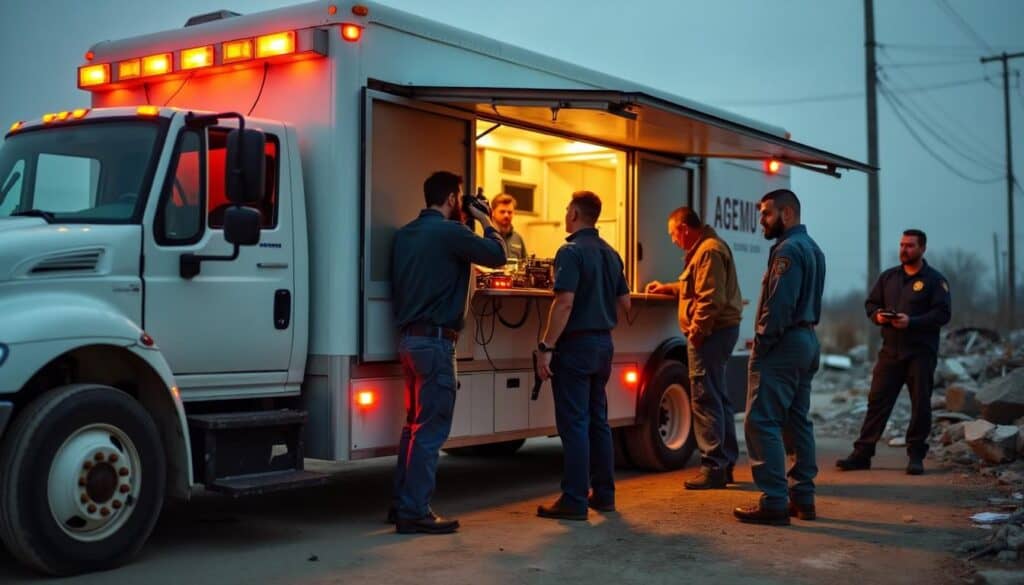
Mobile command centers are like rolling offices on wheels. These high-tech vehicles serve as nerve centers during crises. Picture a big truck or trailer packed with gadgets and tools.
It’s got satellite dishes, cell boosters, and Wi-Fi hotspots to keep everyone connected. These mobile hubs cost a pretty penny – anywhere from $200,000 to over $1 million for a new one. 1 But they’re worth their weight in gold when disaster strikes.
These command centers shine brightest when regular systems fail. Think floods, hurricanes, or wildfires that knock out power and phones. That’s when these mobile units roll in to save the day.
They set up shop right where they’re needed most. Rural areas hit by natural disasters often struggle with communication. A mobile command center trailer can bridge that gap, keeping rescue efforts on track.
It’s like having a mini-Pentagon that can go wherever trouble pops up. 2
Essential Functions of Mobile Command Centers
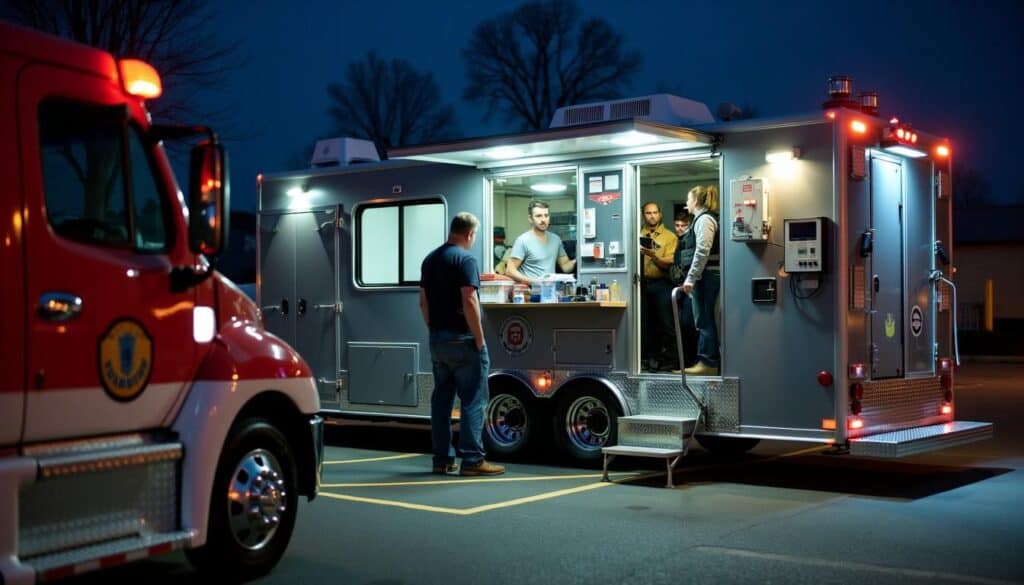
Mobile command centers are the unsung heroes of crisis response. They’re like Swiss Army knives on wheels – packed with tools and tech to tackle any emergency head-on.
Enhancing Public Safety and Emergency Response
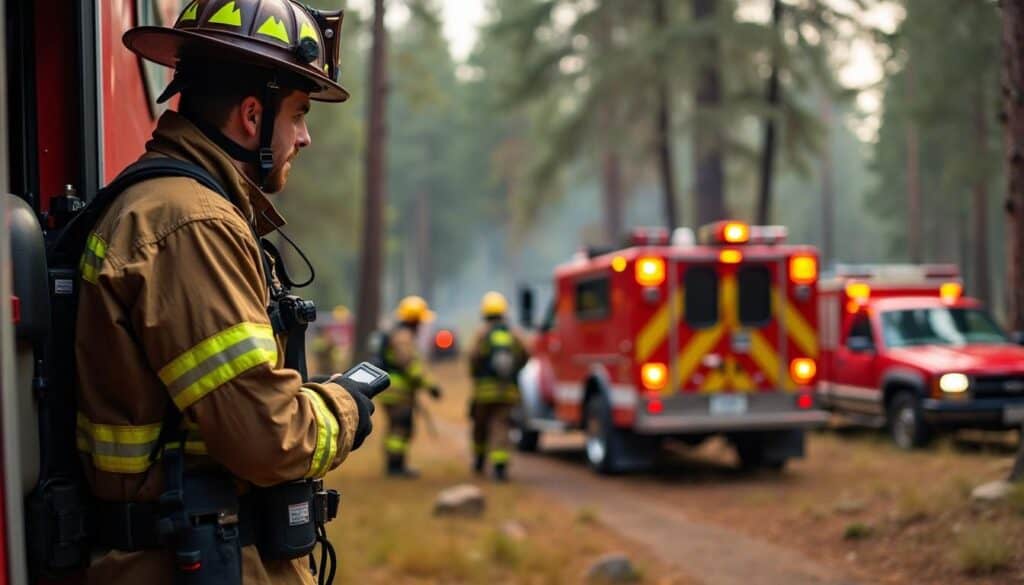
Mobile Command Centers (MCCs) are changing the game for public safety. These high-tech units serve as moving headquarters during crises. They’re loaded with cutting-edge gear – from public safety software to specialized emergency equipment.
MCCs improve communication and coordination among first responders. This leads to faster, smarter responses when every second matters. 2
Imagine a forest fire out of control. An MCC arrives, becoming the hub for firefighters, police, and paramedics. It’s got real-time mapping, weather data, and direct links to air support.
This tech helps teams work together, saving lives and property. As one fire chief said:.
Our mobile command center is like having the entire fire station on wheels. It’s changing how we handle big blazes.
Now, let’s look at how MCCs improve command and control operations. 3
Streamlining Command and Control Operations
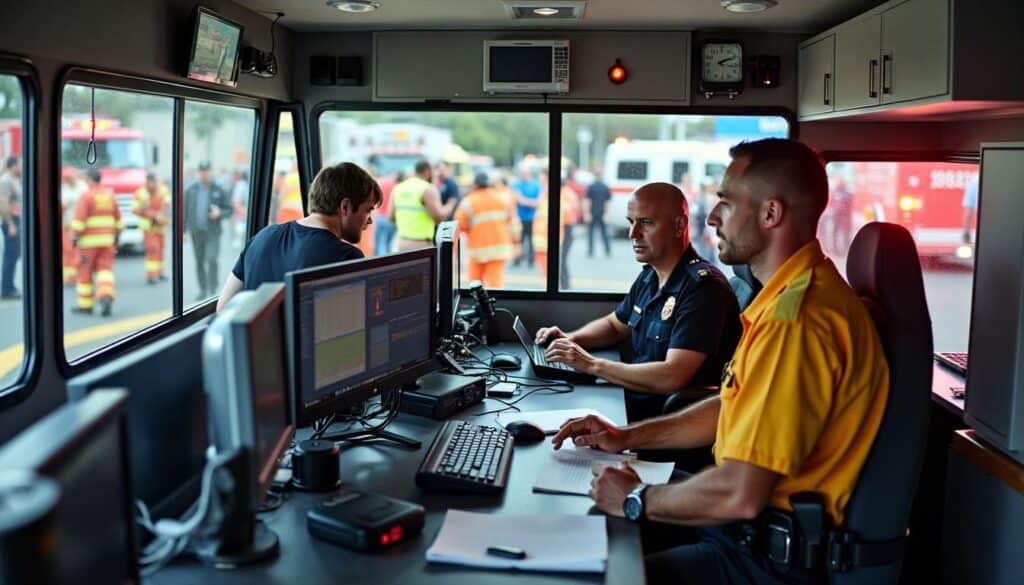
Mobile command centers make running operations smoother. They put all the key players in one spot, so decisions happen fast. These units have video screens, computers, and other tech to keep everyone on the same page.
It’s like having a high-tech war room on wheels. 4
Agencies work better together in these mobile hubs. Police, fire, and medical teams can share info quickly. This teamwork is crucial during big emergencies. The command center becomes the brain of the operation, helping leaders make smart choices when every second counts. 2
Coordinating Crisis Management Efforts
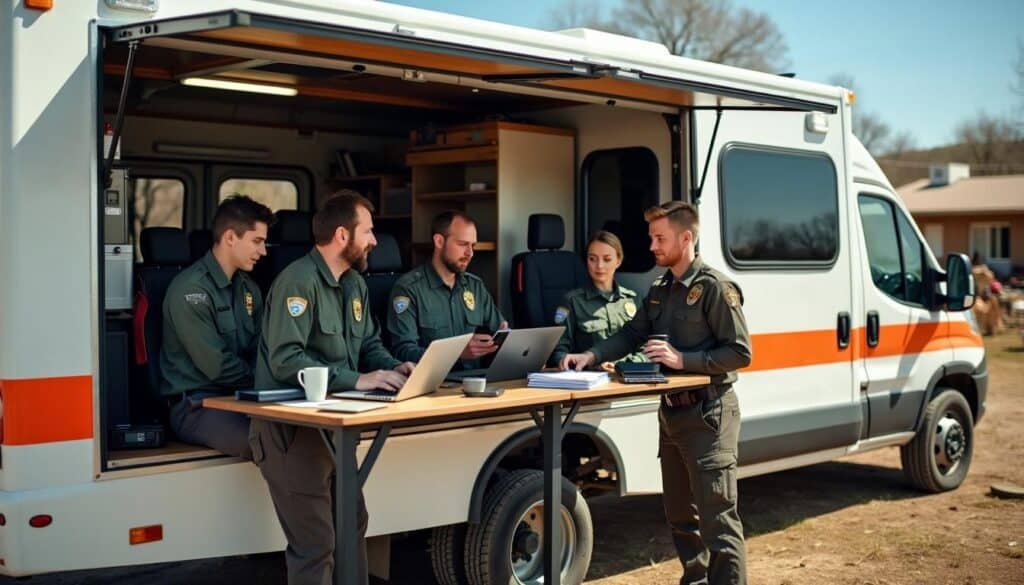
Building on the streamlined command structure, mobile command centers excel at coordinating crisis management efforts. These units serve as crucial hubs for emergency responders during the first 72 hours of a disaster.
They bring together various teams – from search and rescue to medical services – under one roof. This setup allows for quick decision-making and swift action when every second counts. 2
Mobile command centers shine in rural areas where regular communication might fail. They come equipped with satellite tech and Wi-Fi, keeping everyone connected. These rolling nerve centers can park right at the disaster site, giving responders a bird’s-eye view of the situation.
From here, they can direct resources, track progress, and adapt plans on the fly. It’s like having a portable mission control for any emergency – ready to roll wherever disaster strikes. 5
Key Components of a Mobile Command Center
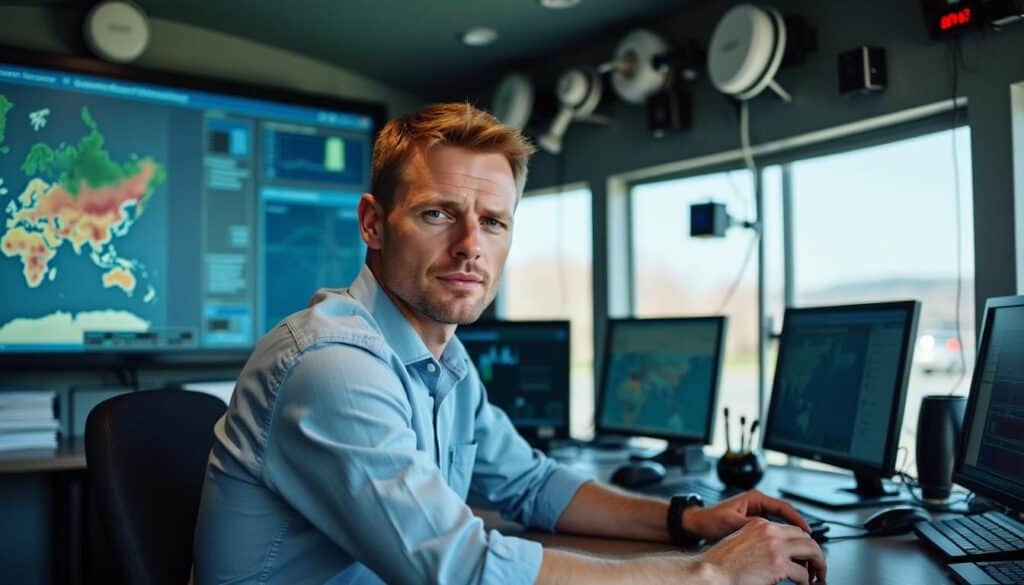
Mobile command centers pack a punch with their high-tech gear. Want to know what makes these rolling HQs tick? Keep reading!
Advanced Communication Technologies
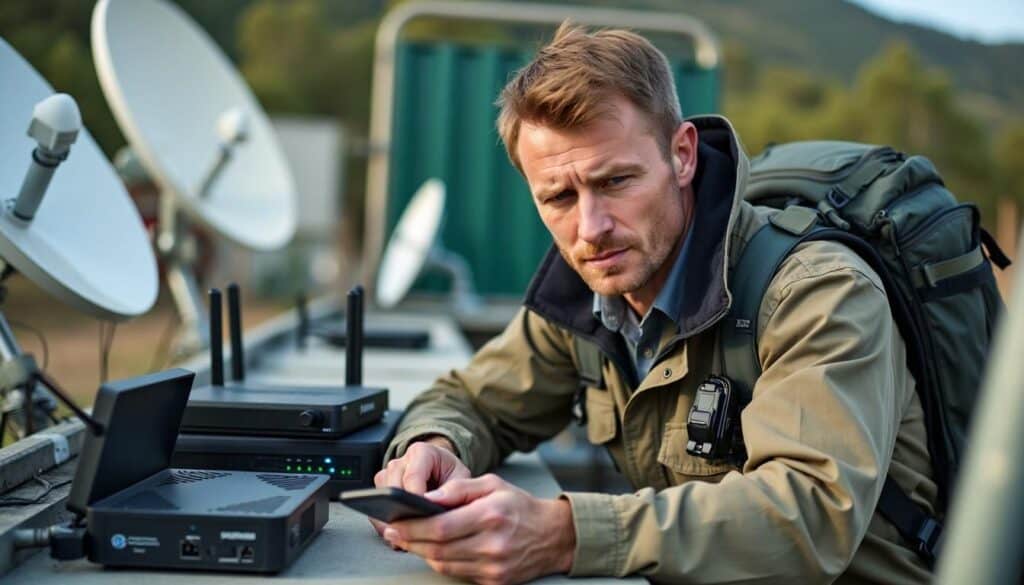
Mobile command centers pack a serious punch when it comes to staying connected. They’re loaded with cutting-edge tech that keeps everyone in the loop. Satellite dishes beam signals from space, while cellular routers like the Digi TX keep data flowing even in tough spots. 1 These bad boys are built tough and super secure – perfect for when things get dicey. Plus, they’ve got this cool trick called WAN bonding that picks the best connection available.
It’s like having a superpower for staying online!
But that’s not all! These command centers take security seriously. The Digi TX routers are FIPS-140-2 certified, which is fancy talk for “government-approved secure.” 4 And let’s not forget about 5G – it’s the secret sauce that keeps everything humming along.
With Digi Remote Manager, the tech wizards back at base can keep an eye on all the gadgets out in the field. It’s like having a crystal ball that shows you exactly what’s going on with your gear, no matter where it is. 4
Specialized Equipment for Mobile Crime Labs
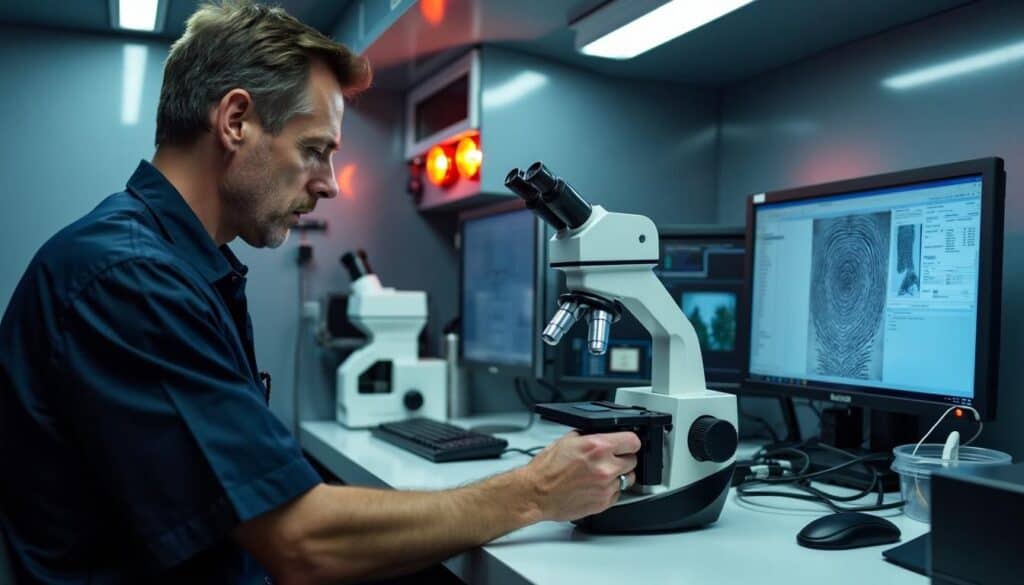
Mobile crime labs pack a punch with their high-tech gear. These labs come loaded with tools for on-site evidence analysis. Think microscopes, fingerprint scanners, and DNA testing kits.
They’ve got it all! This setup lets cops process clues right at the scene. No more long waits for results from far-off labs. 5
But that’s not all. These rolling labs also sport video screens and powerful computers. Detectives can tap into databases, share info, and plan their next moves. It’s like having a mini police station on wheels.
With all this tech, solving crimes gets faster and smarter. Next up, let’s check out the different types of mobile command centers out there. 6
Customization Options for Specific Tasks
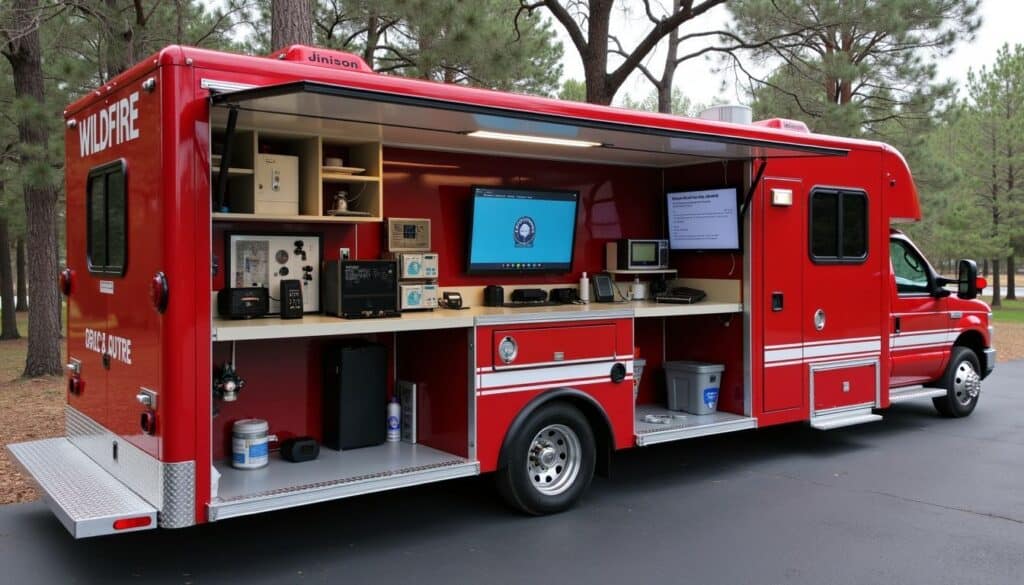
Mobile command centers can be customized for any crisis. Need to handle wildfires? There’s a setup for that. Dealing with floods or hazmat situations? No problem. These centers come with all the bells and whistles – from high-tech comms areas to mini-kitchens.
They even pack multiple screens and power backups to keep things running smoothly. 2
Flexibility is key in emergency response.
For agencies on a budget, portable options are a game-changer. These compact units, about the size of a briefcase, can ride along in police cars, ambulances, and fire trucks. They’re perfect for rural teams who can’t afford big vehicles.
With web-based access, these mini command posts keep everyone connected – no matter where disaster strikes. 2
Varieties of Mobile Command Centers
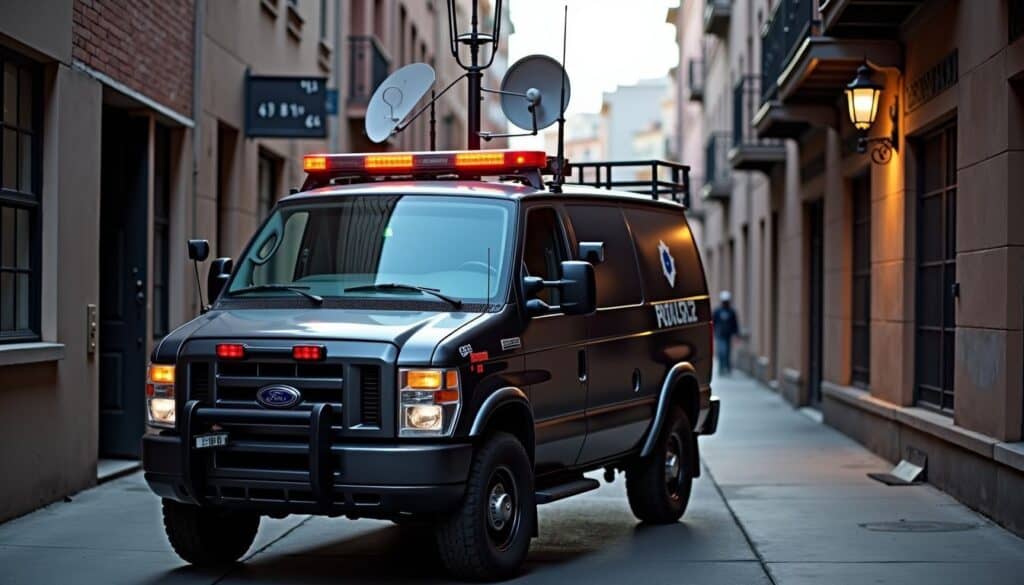
Mobile command centers come in all shapes and sizes. From police vans to fire trucks, these rolling HQs are ready for action.
Mobile Command Centers for Police Operations
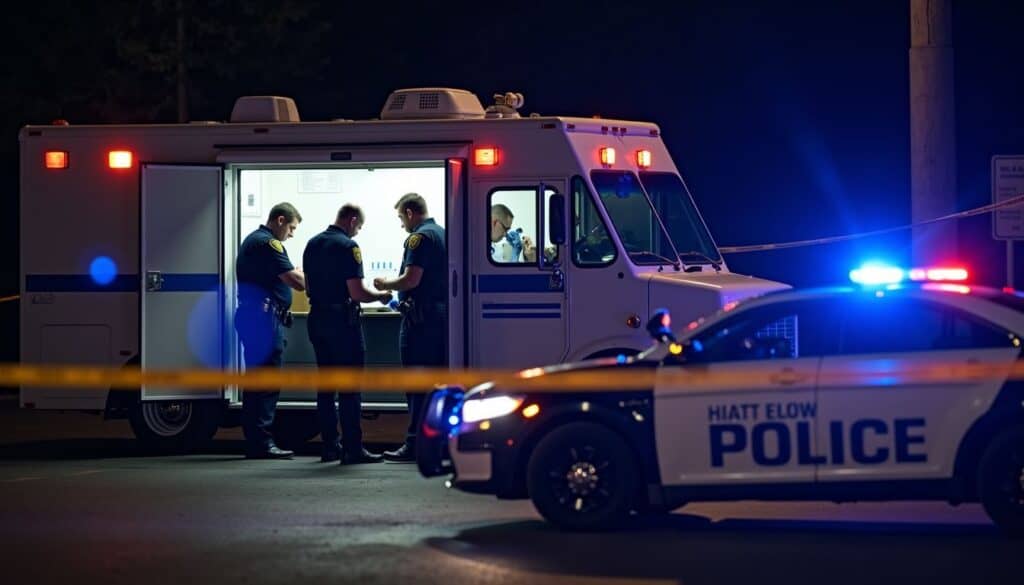
Police mobile command vehicles (MCVs) are game-changers in law enforcement. These rolling HQs pack a punch, loaded with high-tech gear and comms systems. They’re like Swiss Army knives on wheels – ready for anything from major incidents to large events.
MCVs can zip to crime scenes, set up shop, and start cracking cases right away. They’ve got all the tools for on-site evidence analysis, which speeds up investigations big time. 7
But that’s not all… These mobile crime labs also keep an eye on high-crime areas. They’re like mini police stations that can park anywhere. With top-notch surveillance systems, they help cops respond fast to threats.
It’s like having eyes and ears everywhere. Next up, let’s check out how these command centers help during disasters. 2
Mobile Operations Centers for Disaster Response
While police operations rely on mobile command centers, disaster response teams have their own specialized units. These Mobile Operations Centers (MOCs) are the backbone of crisis management during natural disasters, pandemics, and other large-scale emergencies.
They’re like Swiss Army knives on wheels – packed with tools and tech to handle any situation.
MOCs are crucial in the first 72 hours of a disaster. They zip into action, providing a hub for FEMA and other agencies to coordinate relief efforts. 8 These rolling command posts come equipped with satellite links, ensuring communication even when local networks are down.
They’re especially vital in rural areas, where they can be the only lifeline for emergency medical services. MOCs also help build trust with communities by engaging locals in disaster prep. 2
Mobile Operations Centers are the nerve centers of disaster response, bringing order to chaos when every second counts.
Command Centers for Fire and Rescue Services
Fire and rescue mobile command centers are like high-tech nerve centers on wheels. They’re packed with tools to help firefighters and rescue teams work smarter and faster. These rolling hubs boost teamwork during tough situations, like big fires or hazmat spills.
They’re the go-to spot for chiefs to plan and make quick choices. 2
Inside these mobile HQs, you’ll find screens showing real-time info about where firefighters are and who needs help. They’ve got spaces for meetings and planning, too. The tech inside helps teams crunch data, look at maps, and share what’s happening on the ground.
It’s all about giving rescuers the edge when every second counts. 9
Mobile Command Units in Military Operations
Mobile command units are the military’s secret weapon in tough spots. These high-tech trucks pack a punch, loaded with gear to run ops from anywhere. They’re like rolling war rooms, letting brass call the shots right from the front lines.
During exercises or real missions, these units become the nerve center. Troops rely on them for intel, orders, and staying connected. 1
These mobile HQs aren’t just fancy RVs. They’re built to take a beating and keep on ticking. Inside, you’ll find screens lit up with maps and data feeds. Radios crackle with chatter from all over.
It’s where plans come to life and quick decisions save lives. The best part? They can pack up and move fast when things get hot. That’s why they’re a game-changer for today’s fast-paced military ops. 2
Advantages of Using Mobile Command Centers
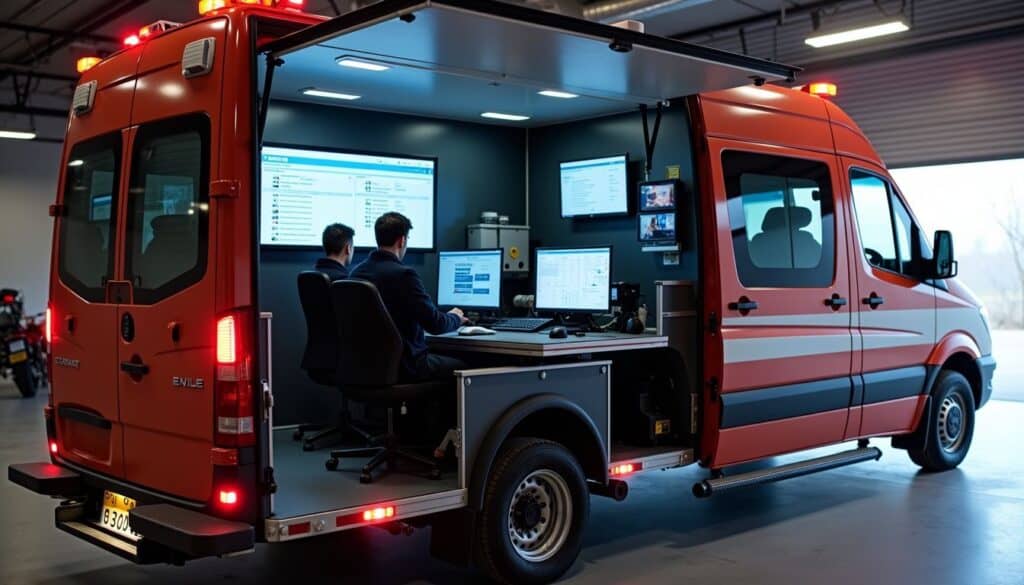
Mobile command centers pack a punch in crisis response. They’re like Swiss Army knives for emergencies – versatile and ready for action. Want to know how they can save the day? Keep reading!
Boost Communication Capabilities in Remote Locations
Mobile command centers are game-changers for remote areas. They bring top-notch communication tools to places where cell towers and Wi-Fi are scarce. A massive truck rolls into a tiny town hit by a tornado.
Inside, it’s packed with satellite phones, radios, and internet gear. This tech lets rescue teams talk to each other and get real-time info about the disaster. 10
These centers don’t just talk the talk – they walk the walk. They act like pop-up networks, giving first responders a lifeline when every second counts. In rural spots facing floods or fires, these mobile hubs keep everyone in the loop.
They’re not just fancy trucks… they’re lifesavers on wheels, making sure help gets where it’s needed most. 5
Secure Communications for Emergency Responders
Boosting communication in remote spots is great, but keeping those chats safe is just as crucial. Emergency responders need to talk without worrying about prying eyes or ears. That’s where secure comms come in handy.
FirstNet® and Verizon Frontline are the big guns here. They offer top-notch networks that keep info locked down tight during crises. 4 These systems use fancy tech like the Digi TX cellular router.
It’s a beast at keeping folks connected, even when things get dicey. Plus, it plays nice with Wi-Fi 6 – the new kid on the block for speedy wireless. 2 Digi SAFE™ takes it up a notch, making sure emergency vehicles are always ready to roll with rock-solid connections.
It’s like having a comms superhero in your pocket!
Provide Flexibility and Mobility During Crises
Mobile command centers shine during crises. They zip to trouble spots fast, bringing help where it’s needed most. 2 These rolling nerve centers can set up shop anywhere – from busy city streets to remote wilderness areas.
They’re like Swiss Army knives for emergency teams, packed with tools and tech to handle any situation.
I’ve seen these bad boys in action. Once, during a nasty wildfire, our mobile unit rolled right up to the fire line. We had eyes on the blaze, talked to crews on the ground, and made quick decisions.
No waiting for info to trickle back to HQ. We were right there, calling the shots. It’s this kind of flexibility that can make or break a crisis response. 5
People Also Ask
What’s a mobile command center and why is it important?
A mobile command center is a high-tech vehicle that serves as a hub during crises. It’s packed with gadgets like surveillance equipment, Wi-Fi, and laptops. These centers are crucial for emergency management, helping coordinate responses to disasters, accidents, and even cyberattacks.
How do mobile command centers help in mass casualty incidents?
In big emergencies, these centers are lifesavers. They help set up field hospitals and coordinate EMS agencies. They’re the brain behind triage operations, making sure the injured get help fast. It’s like having a mission control on wheels for disaster relief.
What role do these centers play in law enforcement?
For police departments and SWAT teams, mobile command centers are game-changers. They provide real-time info during standoffs or counterterrorism ops. With surveillance footage and aerial views from drones, they boost situational awareness. It’s like giving cops superpowers!
How do they support search and rescue efforts?
When people are lost in forest fires or floods, these centers become lifelines. They coordinate search teams, track their movements, and analyze environmental data. With their powerful communication tools, they keep everyone in the loop. It’s like having a guardian angel for rescue missions.
What’s their role in protecting critical infrastructure?
Mobile command centers are watchdogs for our vital systems. They monitor powerlines, water supplies, and more. During threats like cyberattacks or hazardous material spills, they’re the first line of defense. They’re like a shield for our nation’s backbone.
How do these centers aid in public health emergencies?
In health crises, mobile command centers become nerve centers. They help track outbreaks, coordinate vaccine distribution, and manage field hospitals. With their communication tools, they keep the public informed. It’s like having a rolling CDC headquarters!
References
^ https://connectedsolutionsgroup.com/what-is-a-mobile-command-center/ (2023-05-21)
^ https://www.comprehensivecom.net/how-mobile-command-centers-play-a-pivotal-role-in-crisis-management/ (2023-07-24)
^ https://www.flymotionus.com/posts/mobile-command-vehicle-importance (2023-12-31)
^ https://www.digi.com/blog/post/mobile-command-center-rolling-tech-and-comms-hub (2023-08-10)
^ https://www.flymotionus.com/posts/value-of-mobile-command-center-security-services (2023-07-17)
^ https://www.craftsmenind.com/blog/mobile-command-centers-features-for-crisis-management (2023-06-30)
^ https://www.kovacorp.com/8-ways-mobile-command-units-used-public-safety-agencies
^ https://sempercomm.com/mobile-command-center-and-disaster-response/
^ https://www.ncbi.nlm.nih.gov/pmc/articles/PMC5048332/
^ https://www.flymotionus.com/posts/benefits-of-mobile-command (2023-11-30)

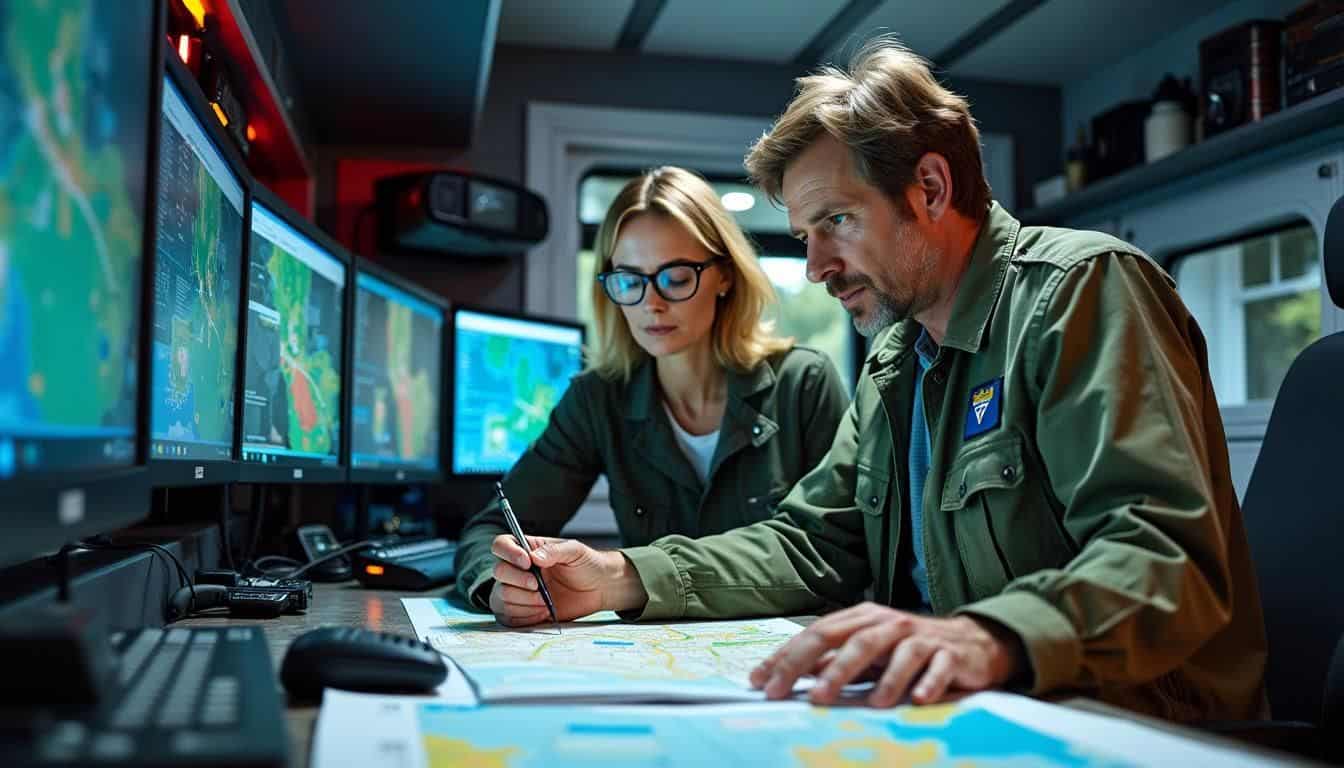

I found the deep dive into mobile command centers genuinely enlightening. As someone who thrives on harnessing the power of cutting-edge technology to solve real-world problems, I appreciate how these mobile units blend high-tech features with critical emergency functionality. The discussion about how they bring robust communication capabilities to remote locations was particularly standout for me. These centers not only embody innovation but also demonstrate impactful application, providing life-saving assistance where traditional methods might fall short. It’s this kind of technology-forward approach that keeps us ahead in times of crisis. This blog post has spurred some thoughts on potential business applications for similar technologies in other high-stakes industries.
This article really opened my eyes to how crucial mobile command centers are, especially in emergencies. I didn’t realize all the tech and coordination that goes into these units. It’s impressive how they can set up anywhere to manage stuff like wildfires or big city crises. It makes you appreciate the advanced planning and investment that goes into public safety. It’s reassuring to know such systems are in place, especially for folks living in more isolated areas where help might not be readily available. The detail about different setups for specific emergencies was particularly interesting, showing how versatile these command centers need to be.
I completely agree with your take on the integration of cutting-edge technology in mobile command centers. It’s fascinating to see how these advancements can be adapted not only for crisis management but could also be visionary for various sectors requiring dynamic operational capabilities. Imagine the potential in industries like construction or large-scale event management, where real-time information and communication are pivotal. The possibilities for deployment across different scenarios are indeed extensive and inspiring. This makes me wonder about the adaptability of such technology in budget-sensitive areas and how it could be cost-effectively implemented to maximize both assistance and operational efficiency. What do you think are the key considerations for making such technologies more accessible without compromising on their effectiveness?
This blog post really underscores the critical roles that mobile command centers play in crisis response. It’s fascinating to see how these high-tech hubs facilitate such crucial communication and coordination during emergencies. As someone who values being prepared and responsive, I appreciate the insight into how these centers operate on the ground, especially in remote areas. It’s incredible to think about the level of technology and planning involved in deploying these units to support emergency responders. Thanks for shedding light on such an impactful topic!
This article really highlights how essential and versatile mobile command centers are, especially in times of crises. The investment might seem steep initially, ranging from $200,000 to over $1 million, but the breadth of their capabilities justifies the cost. They’re not just for large-scale operations but can be critically helpful in enhancing communication and coordination even in remote areas, which is a necessity rather than a luxury during emergencies. The customizable options for specific needs like wildfire or flood response also make them invaluable assets. It’s fascinating to see such a detailed overview of how these mobile units serve multiple emergency response roles effectively.